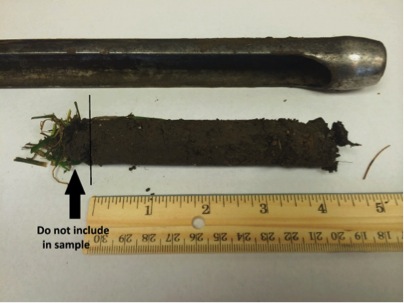(By Zane Raudenbush1, Jared Hoyle1 and Robert Florence2; 1KSU Turfgrass Research and Extension, 2Dept. of Agronomy – Soil Lab Manager)
Fall is an important time for cool season turfgrass species because air and soil temperatures are optimal for carbohydrate accumulation and root growth. However, adequate plant nutrition is essential for these processes to operate at maximum efficiency. The importance of using soil test reports to guide fertilization programs cannot be emphasized enough. The Kansas State Soil Testing Lab (http://www.agronomy.k-state.edu/services/soiltesting/) provides a variety of high quality testing services for turfgrass managers. Testing for pH, phosphorus (P), and potassium (K) can be done for $6.50. A good sampling method is necessary to ensure the soil test results are accurately representing the sampled area. To sample, use a soil probe an extract a 4” to 6” core. The leaf and thatch material should be discarded from the core (see picture). Eight to ten individual cores should be extracted and combined into a single sample for testing. Results are typically sent back within a week of the lab receiving the sample. Fertilizer recommendations will also be provided by a county agent or K-State horticulturalist.
 Of all the possible nutrients, potassium is of particular interest as temperatures continue to decline, because it helps the plant acclimate to cold temperatures. Some soils, especially golf greens, throughout Kansas are low in potassium, leaving turfgrass more susceptible to winter injury. Deficiencies can be addressed by applying K containing fertilizers, such as, potassium chloride (KCl), potassium sulfate (K2SO4), and potassium nitrate (KNO3). Remember, soil tests are a relatively inexpensive tool, but provide a wealth of knowledge.
Of all the possible nutrients, potassium is of particular interest as temperatures continue to decline, because it helps the plant acclimate to cold temperatures. Some soils, especially golf greens, throughout Kansas are low in potassium, leaving turfgrass more susceptible to winter injury. Deficiencies can be addressed by applying K containing fertilizers, such as, potassium chloride (KCl), potassium sulfate (K2SO4), and potassium nitrate (KNO3). Remember, soil tests are a relatively inexpensive tool, but provide a wealth of knowledge.
